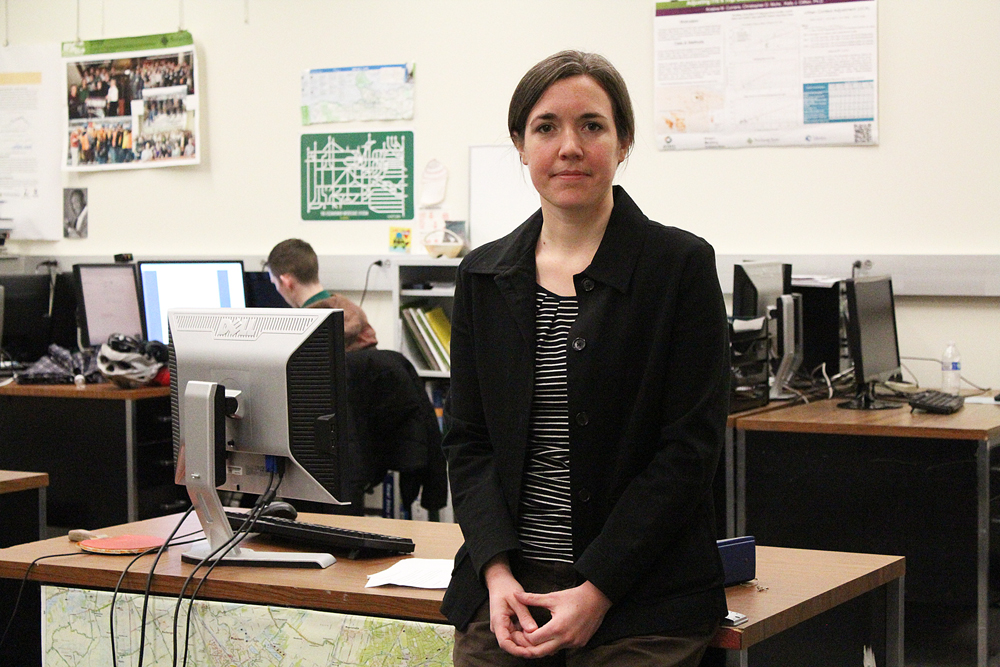Have you ever wondered what Earth looks like from above? As time goes on and technology continues to progress, the possibility of inexpensive space travel is nearly within reach.
Portland State’s Cameron Smith, a professor of anthropology, has already taken a step in that direction by creating an affordable space suit with a cost of $1,000, a fraction of the price of NASA’s quarter-million dollar high-altitude space suits.
So far he has acquired a team of student volunteers, moved the construction to ADX Portland—a light industrial site in Southeast Portland—and he’s joined forces with Danish non-profit space flight company Copenhagen Suborbitals, who will eventually be using Smith’s pressure suits for their astronauts.
Smith began putting the suit together using parts purchased from eBay and building it in his Portland apartment with no outside help. His purpose was plain and simple: to democratize space travel.
The specific type of suit Smith is creating is a pressure—or high-altitude—suit designed to provide protection by pressurizing the body when worn at high altitudes.
“Within a generation, plane tickets were in everybody’s reach and with technology it’s become relatively safe,” Smith said. “That’s what’s happening now with space access, so there will be a lot of disasters and it will be very expensive for a while, but [then] it will come way down.”
Word of Smith’s project has taken flight since he began and it has allowed him to expand his plans.
In February 2013, Kristian von Bengtson, flight director at Copenhagen Suborbitals, reached out to Smith after seeing an article about his space suit in Wired Magazine.
“I was amazed and could see he had the same approach as we do,” von Bengtson said. “Eventually Copenhagen Suborbitals decided to have a space suit as part of the project. We are happy that [Smith] accepted.”
The organization in Denmark is a suborbital space enterprise, based on donations and sponsors, that creates different space vehicles solely for the experimentation of the future of space democratization.
Copenhagen Suborbitals happens to hold a very similar mission to Smith’s, which is, according to their website, to “launch human beings into space on privately [built] rockets and space crafts,” which is why they took great interest in Smith’s work.
“I believe that this project will be a major part in showing everyone that manned spaceflight does not belong solely to large corporations and governments. When [Smith] and Copenhagen Suborbitals succeed [in] doing this, everyone will look at spaceflight with completely different eyes,” von Bengtson said.
In August 2013, Smith traveled to Denmark with his prototype space suits at his side in a trunk, to display and test his creations.
Smith explained the results of those tests done in Denmark.
“They function—we tested the suit in an altitude chamber [at Copenhagen Suborbitals] and it did exactly what it was supposed to do,” Smith said. “It kept my blood oxygenation levels where they should have been, with pressure in the suit, rather than what they would have been with the lower pressure in the chamber if I had not been wearing the suit.”
The success of the demonstrations set the manufacturing of suits for Copenhagen Suborbitals into motion. With the growing opportunities arising with the suit, Smith confesses, “I couldn’t do it alone anymore, I needed more help.”
Smith began acquiring student volunteers after an article recognizing his work was published in the Vanguard in October 2012, and has now stabilized a solid group of six volunteers.
With the helping hands of these volunteers, several parts of the suit could then be under construction at the same time. The volunteers are also working on the interior of an open capsule that’s 2.6 meters in diameter and made for manned flight.It will contain a seat, controls for the person in flight to operate the descent and a radio to allow communication between the flyer and the team on the ground.
One student volunteer, Alexander Knapton, a senior at PSU majoring in social science with a minor in sustainability, is working on the capsule’s life support system, along with the suit.
“I’m hoping this will be the lead into other space exploration opportunities to me and the rest of the group,” Knapton said. “Before meeting professor Smith, I believed it was only an opportunity for the super scientists or people in the military.”
A delicate operation
In late July, Smith will bring the student team to Denmark to pay Copenhagen their first visit and bring over the interior of the open capsule. While only a replica of the full capsule is being built in Portland, Copenhagen Suborbitals is building the exterior based off of Smith’s mock-up plans.
“It’s a very delicate operation,” Smith said. “You begin with the human body to form the suit, then the suit has to fit the seat and the seat has to fit the capsule.”
In Denmark, the team will only demonstrate how to operate and exit the capsule once it has launched, but the actual launch will come later.
While they have been working on the capsule—the bottom end of the project—Copenhagen Suborbitals is aiding in this too by constructing the top end (or the hydrogen balloon) of the structure that will actually carry Smith up to high altitude. He clarified the necessity for a real-life test.
“To put the suit through realistic tests we need to do a flight where somebody’s life is on the line. They’re [more than] 10 miles up in an open capsule underneath a balloon at 65,000 feet where you need a space suit essentially to survive,” he said, “and that’s coming in 2015. Once we’ve done that, then we’ll have even more confidence in the suit design.”
Smith will be in control of bringing the balloon back down while in the capsule by opening a valve to let hydrogen out of the balloon. The rest of the student team will build ground controls and use radio communications to keep in contact.
Smith expressed great confidence in his projects for the test launch.
“I will feel comfortable because we’re building everything where I can touch and see every single piece being put together,” Smith said. “There’s no black box, no mystery content.”
In the event that Smith is unable to perform the test, there will be a backup who practices every simulation and mock launch. Smith says that the test is “90 percent training and 10 percent actually doing it.”
The flight will end with a water landing of Smith in his capsule into the Baltic Sea.
Prior to his partnership with Copenhagen Suborbitals, Smith had expressed concern of public opinion.
“Copenhagen Suborbitals helped to legitimize this,” Smith said. “Before, it was me at home building this thing in my apartment—it sounded totally crazy. Now it has a much more important purpose, which is the democratization of space which…perfectly fits in with Copenhagen’s mission.”
As for the future of the space suit, Smith says that he never wants to sell his plans, much like the ideals held by Copenhagen Suborbitals.
“They don’t want to sell their stuff. They’re an open source space program in total contrast to others. You can go to their website and download every single plan; every nut and bolt. You could replicate their entire program,” Smith said.
“The whole point is to make this stuff publicly available. To open the gates, rather than having a narrow funnel that people have to get through to get to space.”
Knapton, the social sciences student, expressed the group’s hope for the future of the suit and everyday space exploration.
“Its been proven that over time technology has been dropping off in costs. We’ve seen it with computers and we’ve seen it with just about everything. That’s what we’re hoping to do.”







